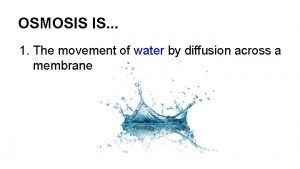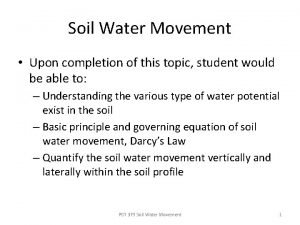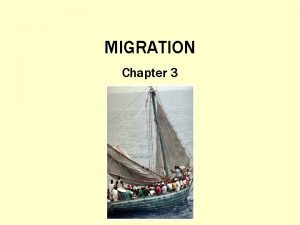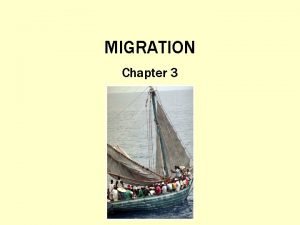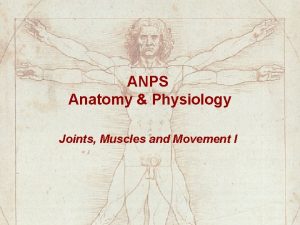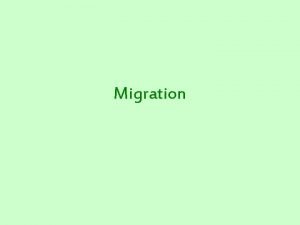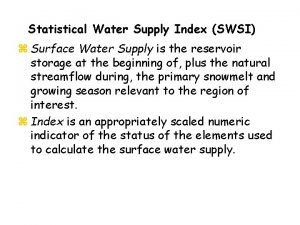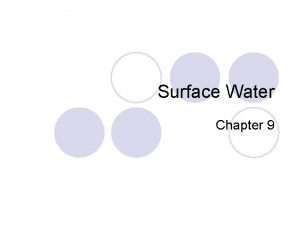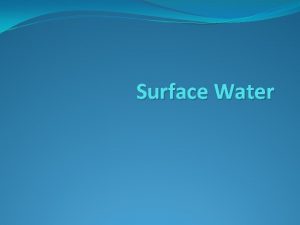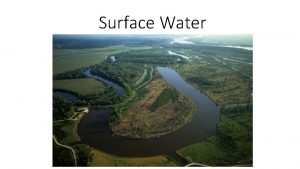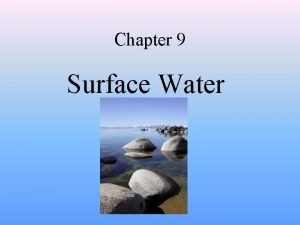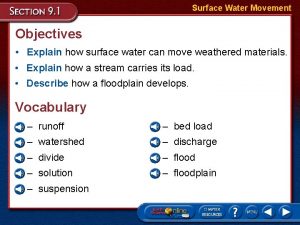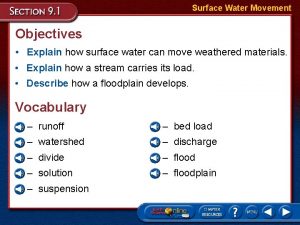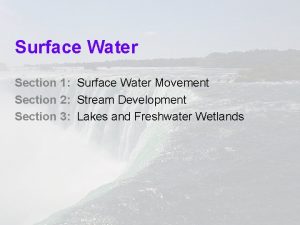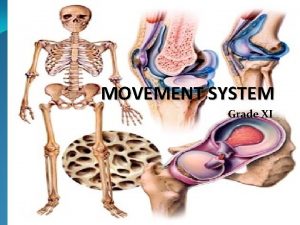Surface Water Movement Surface Water What types of






















- Slides: 22

Surface Water Movement

Surface Water �What types of bodies of water constitute surface water? �River, lakes, streams, ponds, and seas �Where does surface water come from? �Rain, Ice, Snow, and Under the ground

Hydrologic Cycle �Earth’s water supply is recycled in a continuous process

Hydrologic Cycle �Evaporation-Movement of water from Earth’s surface to atmosphere �Condensation- Movement from water vapor to clouds �Precipitation- water falls back on Earth �Infiltration- Water soaking into the Earth �Runoff- water on earth’s surface that flows downslope into lakes, streams, rivers, oceans, or puddles �Transpiration- water vapor from plants; Similar to evaporation

Runoff �A number of conditions determine whether water on Earth’s surface will infiltrate the ground or become runoff. �Vegetation �causes the soil to hold more water � water flows slower down plants allowing the ground to soak in more �Rate of Precipitation�More water enters ground if rainfall is gentle �During heavy downpours , the rate of precipitation may exceed the rate of infiltration

Runoff �Soil Composition: Determines how much water soil can hold �Slope: the steeper the slope, the less water is allowed to soak into the ground

Stream Systems �Stream System- Large river and all of its tributaries �Water flows downslope to lower elevations �Can flow into lakes, oceans and other streams

Stream Systems �Tributaries �Rivers that flow into other streams �Example: Missouri river is a tributary for the Mississippi

Stream Systems �Water Sheds �All of the land whose water drains into a stream �Divide �A high land that separates one watershed from another

Stream Systems �Stream Load: the material that a stream carries. Stream load is carried in 3 ways: 1. solution: material dissolved in water 2. suspension: particles small enough to be held up by the turbulence of moving water (silt, sand, clay) 3. bed load: sand pebbles and cobbles that are rolled and pushed along the stream bed by water

Stream Velocity and Carrying Power �Carrying power: streams ability to transport material; this is dependent on stream velocity and volume �Stream velocity: effected by slope, depth, width of the stream �Discharge: width x depth x velocity �When discharge increases, carrying power increases �Increases during heavy rain, rapid snowmelt, and flooding

Floodplains �Flood- water spills over the sides of stream banks and onto adjacent lands �Floodplain- the area of land covered with stream water during times of floods �When water recedes off the floodplain, sediments are deposited on the land making the soil very fertile

Floods �Upstream flood: the flooding of a small area caused by a sudden rainstorm dropping large amounts of time (flashflood) �Downstream flood: heavy accumulation of excess water from large regional drainage

Streams, Wetlands, and Lakes

Stream Development �Stream formation relies on adequate water supply �As a stream develops it changes width and size, and shapes the land over which it flows

Formation of Stream Valleys �Driving force of a stream- gravity �Stream actively erodes a path through the sediment or rock, a V-shaped channel develops

Meander �As stream channels develop into broader valleys , the volume of water and sediment that they can carry increases. �Sometimes the water begins to erode the sides of the channel in such a way that the overall path starts to bend and wind. �A bend or curve is called a meander.

Meander

Origins of Lakes �Lakes can form from many different sources �Stream flows become blocked �Glacial origins �Melted glaciers �Water from precipitation , runoff, and underground sources can maintain a lake’s water supply

Lakes Undergo Change �Eutrophication: when watershed enriches bodies of water with nutrients that stimulate excessive plant growth �Can be positive or negative

Wetlands �Wetland: low lying area that is periodically saturated with water and support a specific plant species �Areas include bogs, marshes, or swamps

 Water and water and water water
Water and water and water water What is a non movement area
What is a non movement area Non locomotor or axial movements
Non locomotor or axial movements Plant water balance
Plant water balance Xylem
Xylem What is osmosis
What is osmosis Water movement
Water movement Examples of cyclic movement in the environment
Examples of cyclic movement in the environment Camera shots and angles
Camera shots and angles Types of active movement
Types of active movement Bio 137
Bio 137 Cyclic movement
Cyclic movement Musculoskeletal system
Musculoskeletal system Types of joint movement
Types of joint movement Types of social movement
Types of social movement Types of passive movements
Types of passive movements Cyclic movement definition
Cyclic movement definition Movement exploration examples
Movement exploration examples Triangle total surface area
Triangle total surface area High surface tension vs low surface tension
High surface tension vs low surface tension Wet curved surface area
Wet curved surface area Surface water supply index
Surface water supply index Njdep groundwater quality standards
Njdep groundwater quality standards





